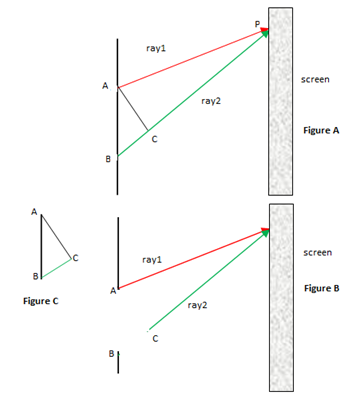Question 5: What is meant by the path difference with reference to the interference of two wave motions?
ANSWER
Path difference definition
The difference in the paths traveled by wavelets from two sources to reach a point ‘P’ on the screen is called path difference.
Calculation

Let’s consider the diagram on the right. Two rays, rays 1 and ray 2, emerging from two slits A and B and are incident on point ‘P’ on the screen. It can be seen that ray 2 (green) travels more distance than ray 1 (red) to reach point ‘P’.
Draw perpendicular from A on ray 2 which meets at point C. Thus ABC is a right angled triangle.
Now drag out the triangle as shown in figure C. The remaining part of the diagram is shown as Figure B. It can be seen that the length of the two rays (ray1 and ray 2) is now equal. So we can conclude that the path difference is BC, which is perpendicular in the triangle ABC with ∠BAC as angle θ.
Now in this triangle; sinθ = (perpendicular)/ (hypotenuse) ⇒sinθ = BC/AB, OR BC = ABsinθ.
But BC = path difference, and AB = separation of slits = d, therefore,
path difference = d sinθ
Path difference and interference
When two identical light waves, like the two shown in the figure, are traveling in the same region, they superpose with one another. This superposition of the waves leads to the interference of the waves. This means they either reinforce the effect of one another or cancel one another. The reinforcement effect is referred to as constructive interference and the cancellation as destructive.
Now if the two waves are reaching a point (for example P in the diagram) in phase they will interfere constructively and if the two waves are anti-phase at a certain point, they will cancel the effect of one another. The path difference has a strong relationship with the phase relation of the waves, and hence with the interference pattern. For constructive interference the condition is;
Path difference = d mλ
where m = 1, 2, 3,
Similarly, for destructive interference to happen;
d = (m + 1/2) λ
Hence, path difference plays a key role in the interference pattern of waves because both constructive and destructive interference are depending on path difference.

Pingback:1546 – msa
Pingback:Brewster’s law of polarization – msa
Pingback:1510